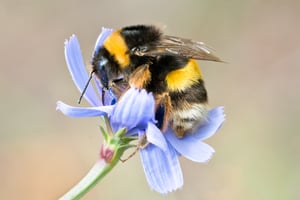 If you’ve had the chance to go hiking this summer in the Colorado Rockies, you may have noticed the myriad of wildflowers rising from their sleepy slumbers to adorn the meadows and slopes of our beloved mountains. Scarlet Gilia boast bright red flowers shaped like trumpets. Columbine open their white and purple pedals stretched wide like the arms of a star. Mule’s Ears gather in clusters yellow and cheerful, seemingly mimicking the sun. In the high alpine, you may be lucky enough to stumble upon a marshy meadow of silky yellow Glacier Lilies, shimmering humbly, heads bowed. Alongside creeks, Bluebells droop, and a succulent called Queen’s Crown bursts with ruby colored flowers looking the way their name alludes to.
If you’ve had the chance to go hiking this summer in the Colorado Rockies, you may have noticed the myriad of wildflowers rising from their sleepy slumbers to adorn the meadows and slopes of our beloved mountains. Scarlet Gilia boast bright red flowers shaped like trumpets. Columbine open their white and purple pedals stretched wide like the arms of a star. Mule’s Ears gather in clusters yellow and cheerful, seemingly mimicking the sun. In the high alpine, you may be lucky enough to stumble upon a marshy meadow of silky yellow Glacier Lilies, shimmering humbly, heads bowed. Alongside creeks, Bluebells droop, and a succulent called Queen’s Crown bursts with ruby colored flowers looking the way their name alludes to.
The idea of beauty in nature could be deemed an opinion, but whether or not you feel captivated by the colorful show of wildflowers in the summer, there is evidence that wildflowers have evolved to attract visitors to them through their flamboyant colors and intoxicating smells, which some people may find “beautiful”. While humans might not be the main interest for wildflowers to attract, it is crucial for a flower’s survival to entice special visitors called pollinators. There is a fuzzy, buzzing pollinator who is especially adapted to appreciating wildflower beauty: the bumblebee.
Bumblebees have good reason to be attracted to wildflowers, as they rely on flowers for their survival. After a cold winter, bumblebees emerge from their underground nests, and wildflowers offer a sweet food source of nectar and pollen to the bumblebees and their offspring. It is truly in the eyes of the “bee-holder” that the beauty of flowers is made known; bumblebees have incredibly adapted vision. While humans can see a spectrum of light which we know as the colors of the rainbow, bumblebees have the amazing ability of seeing ultraviolet light. Wildflowers have learned this, and the pigments of their petals absorb ultraviolet light leaving patterns which act as signals, drawing bees to their nectar-filled centers. When bumblebees do locate the pollen-dusted, nectarous part of a flower, the pollen coats the bumblebee’s fuzzy body and is transferred to other flowers via the vibrating we associate with the buzzing of bees. Without this transfer, wildflowers would have a very difficult time reproducing.
Imagine you’re driving on a highway on a dark night, and the light from your car’s headlights reflects off of mile markers and road lines, guiding you on your way. You see a giant sign in the shape of a pizza flashing yellow and red light, and you become distracted by the vivid colors. As you drive by, you smell the enticing aromas of melted cheese and sizzling pepperoni, and before you know it, you’ve stuffed your face into a delicious piece of pizza. This is the goal of a wildflower in tantalizing pollinators.
In unison with sight, wildflowers also entice the scent receptors of bumblebees. These receptors are located at the base of a bee’s antennas, and allow them to differentiate between flowers, the footprints of other bumblebees, and to locate specific species of flowers. Even the scent-producing cells of a flower are arranged in a pattern, directing bees to the nectar sources. The way that these patterns are arranged is important, because bees are able to remember the shape of the scent patterns. Once the bees learn a scent pattern, they tend to seek out unscented flowers with similar visual patterns, meaning they are able to translate between the two senses. It’s all pretty un-bee-lievable!
Wildflowers and pollinators like bumblebees have been evolving alongside one another for centuries. Flowers depend on bumblebees finding them beautiful through their senses in order to survive, and bumblebees need the guidance of colors, scents, and shapes of flowers to find food for the success of their survival. In nature, this is called a mutualistic symbiotic relationship, because both organisms benefit. There are so many reasons that humans benefit from the relationships that pollinators and wildflowers have too. Without pollinators we wouldn’t have food, clean air, or wildflowers to admire, so if you go outside today, be sure to tell a flower it’s looking pretty, and say thank you to a bumblebee!
References:
- https://www.colorado.edu/cumuseum/sites/default/files/attached-files/thebumblebeesofcolorado-2017.pdf
- https://www.fs.fed.us/wildflowers/pollinators/pollinator-of-the-month/bumblebees.shtml
- https://www.adirondackalmanack.com/2020/05/bumblebees-out-of-the-shadows.html
- https://www.cam.ac.uk/research/news/flowers-tone-down-the-iridescence-of-their-petals-and-avoid-confusing-bees
- https://www.independent.co.uk/news/science/bees-flowers-smell-bumblebee-scent-buzz-pollen-hive-a8396126.html








